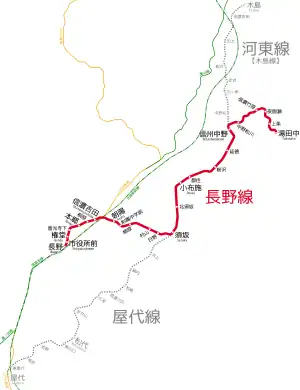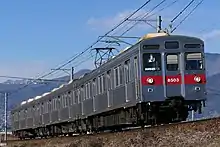| Nagaden | |
Native name | 長野電鉄 |
Romanized name | Nagano Dentetsu |
| Type | Public K.K. |
| Industry | Conglomerate |
| Founded | May 30, 1920 |
| Headquarters | , Japan |
Area served | Nagano. |
Key people | Tohei Kodu (founder)[1] |
| Services | passenger railways other related services |
| Owner | Kitano Construction[2] (8.56%) Hachijuni Bank (3.73%) Dai-ichi Hoki (1.04%) |
| Subsidiaries | Nagaden Bus |
| Website | www |

The Nagano Electric Railway (長野電鉄, Nagano Dentetsu) is a private railway based in Nagano, Japan. The company and its line are commonly referred to as Nagaden (長電). It originally operated three lines, but only the Nagano Line between Nagano — Suzaka — Shinshū-Nakano — Yudanaka remains in service. Nagaden makes a 1.1% investment in Shinano Railway.
Operations
The Nagano Line has frequent local and express services. It is a major route for commuter traffic in Nagano, and also serves as a link for tourists going to the town of Obuse, the hot springs at Yudanaka, and the ski resorts at Shiga Kōgen.
At limited times throughout the year, there are special reserve round-trip trains between Nagano and Obuse several nights a week in which customers are served a local, specially-made bento and drink local alcohol. For example, on select evenings in March and April, local nihonshu.[3] At other seasons, a beer train on the same route is available. In addition, a wine-tasting train from Nagano to Yudanaka or Yudanaka to Nagano is available on select Saturdays throughout the year.
Stations
● Means all trains stops at this station.
|Means all trains passes at this station.
| No.[4] | Station name | Japanese | Distance (km) | Limited Express | Connections | Tracks | Location | |||
|---|---|---|---|---|---|---|---|---|---|---|
| Between stations | Total | B | A | S | ||||||
| N1 | Nagano | 長野 | - | 0.0 | ● | ● | ● | Shin'etsu Main Line Shinano Railway Kita-Shinano Line |
Two | Nagano |
| N2 | Shiyakushomae | 市役所前 | 0.4 | 0.4 | ● | | | | | |||
| N3 | Gondō | 権堂 | 0.6 | 1.0 | ● | ● | ● | |||
| N4 | Zenkōjishita | 善光寺下 | 0.6 | 1.6 | | | | | | | |||
| N5 | Hongō | 本郷 | 1.1 | 2.7 | ● | | | | | |||
| N6 | Kirihara | 桐原 | 0.9 | 3.6 | | | | | | | |||
| N7 | Shinano-Yoshida | 信濃吉田 | 0.7 | 4.3 | ● | | | | | Shinano Railway Kita-Shinano Line (Kita-Nagano) | ||
| N8 | Asahi | 朝陽 | 2.0 | 6.3 | ● | | | | | ∨ | ||
| N9 | Fuzokuchūgakumae | 附属中学前 | 0.7 | 7.0 | | | | | | | | | ||
| N10 | Yanagihara | 柳原 | 1.0 | 8.0 | | | | | | | ◇ | ||
| N11 | Murayama | 村山 | 2.0 | 10.0 | | | | | | | ◇ | Suzaka | |
| N12 | Hino | 日野 | 1.0 | 11.0 | | | | | | | | | ||
| N13 | Suzaka | 須坂 | 1.5 | 12.5 | ● | ● | ● | ◇ | ||
| N14 | Kitasuzaka | 北須坂 | 2.5 | 15.0 | | | | | | | ◇ | ||
| N15 | Obuse | 小布施 | 2.5 | 17.5 | ● | ● | ● | ◇ | Obuse (Kamitakai) | |
| N16 | Tsusumi | 都住 | 1.1 | 18.6 | | | | | | | | | ||
| N17 | Sakurasawa | 桜沢 | 2.7 | 21.3 | | | | | | | ◇ | Nakano | |
| N18 | Entoku | 延徳 | 2.0 | 23.3 | | | | | | | ◇ | ||
| N19 | Shinshū-Nakano | 信州中野 | 2.3 | 25.6 | ● | ● | ● | ◇ | ||
| N20 | Nakano-Matsukawa | 中野松川 | 1.4 | 27.0 | | | | | | | | | ||
| N21 | Shinano-Takehara | 信濃竹原 | 2.3 | 29.3 | | | | | | | ◇ | ||
| N22 | Yomase | 夜間瀬 | 1.1 | 30.4 | | | | | | | | | Yamanouchi (Shimotakai) | |
| N23 | Kamijō | 上条 | 1.4 | 31.8 | | | | | | | | | ||
| N24 | Yudanaka | 湯田中 | 1.4 | 33.2 | ● | ● | ● | | | ||
Rolling stock

- 1000 series 4-car EMUs (2 sets)
- Ex-Odakyū 10000 series HiSE sets for Limited express "A" (Yukemuri) services. Entered service from 9 December 2006.
- 2100 series 3-car EMUs (2 sets)
- Ex-JR Narita Express 253 series sets for Snow Monkey limited express services. Entered service from 26 February 2011.
- 3000 series 3-car EMUs
- Ex-Tokyo Metro 03 series sets for local services. Introduced in January 2020. Scheduled to replace the existing 3500 & 3600 series in 2020.
- 8500 series 3-car EMUs (6 sets)
- Ex-Tokyu 8500 series sets for local services. Introduced in 2005.[5]
Former rolling stock
- 2000 series 3-car EMUs
- For Limited express "B" services. (1957–August 2011)
- 0 series
- For "Officeman & Student" Local services. (1966–2002)
- 10 series
- For "Officeman & Student" Local services. (1980–2017)
- 3500 series 2-car EMUs (14 sets) and 3600 series 3-car EMUs (3 sets)
- Ex-TRTA 3000 series sets for local services. (1993–January 19 2023)[6]
History
The original Nagano Electric Railway was built in 1926, connecting Gondō in Nagano with Suzaka, and electrified at 1,500 V DC. Later that year, the company absorbed the operations of Katō Railway, which operated a line on the east bank of the Chikuma River from Yashiro via Suzaka to Kijima, with the Gongo to Yoshida section being double-tracked. The following year, an additional line was constructed from Shinshū-Nakano to Yudanaka, and in 1928, the line was extended to Nagano Station as dual track.
The Yoshida - Asahi section was double-tracked in 1956, and freight services ceased in 1979. CTC signalling was commissioned between Yudanaka and Asahi in 1980, and extended to Nagano in 1984. The section from Nagano to Zenkōjishita was converted to an underground railway in 1981.
Former connecting lines
- Suzaka Station: The Kato Railway opened a 24 km (15 mi) line to Yashiro on the (now) Shinano Railway Line in 1922, electrified it at 1,500 V DC in January 1926, and merged with the Nagano Electric Railway in September the same year. Due to falling patronage, the line closed on 31 March 2012.[7]
- Shinshū-Nakano Station: The Kato Railway opened the 13 km (8.1 mi) line to Kijima in 1925 and electrified it at 1,500 V DC the following year. Freight services ceased in 1979 and CTC signalling was commissioned on the line in 1980, but due to falling patronage, the line closed in 2002.
Gallery
 Nagaden Beer Train
Nagaden Beer Train Nagaden Beer Train with bento boxes
Nagaden Beer Train with bento boxes Nagaden Local Sake (Jizake) Train
Nagaden Local Sake (Jizake) Train
See also
References
This article incorporates material from the corresponding article in the Japanese Wikipedia.
- ↑ He is Tsutomu Hata's grandfather.
- ↑ Kitano Construction is made a 1.9% investment by Matsuya (department store) and a 1.7% investment by Toei Company
- ↑ "ながでん地酒トレイン".
- ↑ 長野電鉄各駅情報一覧|長野電鉄ホームページ. Nagaden (in Japanese). Archived from the original on 1 September 2014.
- ↑ "東急8500系と田園都市線のあゆみ" [Tokyu 8500 series and the History of the Denentoshi Line]. Tetsudō Daiya Jōhō. Japan: Kōtsū Shimbunsha. 38 (301): 12–21. May 2009.
- ↑ "長野電鉄3500系、最後の現役車両が1/19で完全引退 - イベント開催" [Nagano Electric Railway 3500 series, the last active vehicle will be completely retired on 1/19, Event to be held]. MyNavi Corporation (in Japanese). 22 December 2022. Archived from the original on 22 December 2022. Retrieved 22 December 2022.
- ↑ 長野電鉄屋代線が廃止される [Nagano Electric Railway Yashiro Line Closes]. Japan Railfan Magazine Online (in Japanese). Japan: Koyusha Co., Ltd. 2 April 2012. Retrieved 5 April 2012.
External links
- Official website (in Japanese)